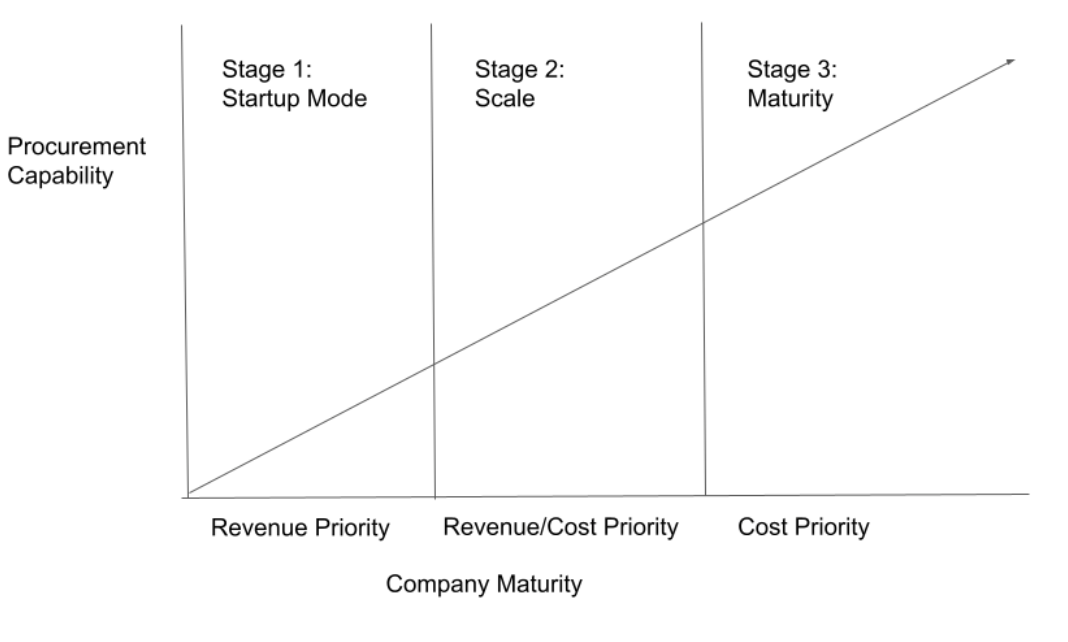Understanding the Procurement Capability Model: Start-Up, Scale, Maturity
As businesses venture through their various lifecycles, procurement practices stay the same.. right? Well, not exactly. Within the lifecycle of a business, you will find that procurement capability will drastically change and become more complex as the business continues to mature.
This is primarily due to experience, complexity, and ultimately the necessity to adequately scale without overwhelming the procurement sector and eliminate the possibility/continuation of out-of-control spending habits. Especially as your operation becomes more complex, the need for more purchasers, contracts, and policies/practices will grow exponentially - which is why your procurement capability shouldn’t be overlooked and needs to be understood thoroughly.
Stages of the Procurement Capability Model
Procurement capability can be simplified and broken up into three main stages: startup, scale, and maturity.
Stage 1: Start-up - By far the most lawless and least restricted stage when it comes to procurement is the start-up phase. When a company is fresh and new, they are entirely focused on revenue growth and will do whatever it takes to grow revenue - even at the sacrifice of the bottom line. There will be minimal to no barriers when it comes to procuring what is needed and as fast as possible, which could even lead to out-of-control spending habits for businesses that are trying to grow too rapidly during the startup phase. It is typical for there not to be any procurement policies in place and it is likely that a buyer or administrator is executing the purchase requests while a business requester will conduct any and all negotiations (if there even are any negotiations).
Stage 2: Scale - If a company survives the startup phase, this probably means that they continued to grow revenue in a healthy manner and may even be considering going public once the company reaches $100M+. As the company continues to scale, this will usually require the need for additional buyers and the development of a procurement team. A procurement manager may be hired to oversee a team of buyers, implement and enforce procurement policies, and attempt to streamline procurement processes with the new policies in place. The company is still primarily focused on revenue growth and the business requestors are still doing the negotiating. Over time as the company matures the revenue growth may begin to slow and this is where the first concept of “cost containment” begins to play a role in the company’s decision-making. Procurement will begin to focus on enhancing policies and search for any way to optimize spend, especially if the company hits a period of slow revenue growth like a recession.
Stage 3: Maturity - After the “scale” phase is complete and revenue growth has slowed, becoming cost conscious is a primary focus of the mature company. The CFO will ask procurement to implement a metric that will track cost savings and ensure that the majority of spend is “managed” by the procurement team. There may even possibly be the implementation of a “competitive bid (CB) policy”, in which competitive bids must be conducted for all purchase requests over a certain dollar threshold. Financial Planning & Analysis (FP&A) may also take a stronger role by reviewing all spend requests to ensure that budgetary and spend requirements are met.
Throughout these stages, you can see that the mindset changes from “more revenue” to “cost containment” as a business continues to progress. Amongst all of these stages, there are various mistakes that are made that can be detrimental to a business - especially within procurement. It is a must to understand what stage your company is in as it allows you to develop the adequate strategy and approach necessary to further enhance your procurement capability.
Where is My Company in Procurement Capability?
You may be thinking: where is my company in its procurement capability? While procurement capability does depend on your company’s maturity, there are a multitude of factors to consider such as your company’s business model and the current macroeconomic situation.
As your company matures, procurement will play a stronger role in governance and managing spend. This will ultimately lead to procurement speed being adversely impacted due to required governance and compliance requirements. While there needs to be checks and balances within procurement to eradicate out-of-control spending, procurement speed should always be a priority.
If you are finding it challenging to identify where your company is in its procurement capability and seeking methods to optimize your procurement processes - you are not alone. It takes years and an experienced company to really hone in on their procurement capabilities, but you don’t want to fall behind the curve.
Mike Glass runs GPC (Glass Procurement Consulting), a procurement consulting firm focused on optimizing a company's spend. Mike has worked in senior procurement management positions at NVIDIA, Google, Meta, Fitbit, and Flextronics. Mike would enjoy getting your insight on any procurement topic, feel free to contact Mike at mike@glassprocurementconsulting.com.


